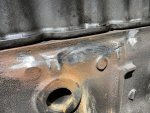kaeden1100
Cadet
- Joined
- Jun 23, 2020
- Messages
- 27
That has a crack-like appearance.
That's the same thing I thought when I saw it, however after cleaning it up, it doesn't really look like it's a crack. I even took a file and a screwdriver and tried to kind of "dig" into it to see if I could see an actual crack but there's nothing. It almost looks like a protrusion (maybe from a poor cast?) than a crack. Either that or maybe once upon a time it was cracked and then filled? Let me ask you this..
I decided to go ahead and pull the head, just to double check the head gasket and to see if I could get a better look at the rest of the block. The head gasket was definitely blown. I couldn't get a picture good enough for it to show on camera, but you could clearly see scorching on the gasket between cylinders 3 and 4 I believe if I remember correctly. You could also tell by looking at the head that cylinder three had been running colder than the rest (presumably due to cold combustion from the water getting into the cylinder). Now, my question is, almost all of the head bolts were wet coming out except for the two or three on the right side of the block (if looking at it from the front of the motor). These bolts would've lined up almost perfectly with the freeze plugs on that side of the block. I was talking to my dad about it (who's worked on engines and such for most of his life) and he said that it's possible there may have been a crack at one time and the block was sealed, causing what should've been water jackets right there to no longer get water. This seem feasible to anyone? Honestly just trying to figure out if it's worth even putting back together or if you guys are almost positive there was/is still an issue with the block. Like I said, head gasket was obviously bad so that's what I was leaning towards for the whole water in the oil issue but maybe I'm wrong?
Thanks again for all the help so far!




















